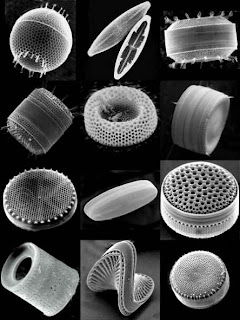
Just a thought, but started thinking about diatoms. when they were first observed, and the inclusion of form in drawing... a good blog about atlantis and Bacon is here,
“This theory proposes that the Voynich Manuscript may be a faux book, which was created between 1610 and 1620, and made to look as though it came from Francis Bacon’s fictional island of New Atlantis. And as such, that it was made to look much older than it was, and that it includes a map of the fictional Bensalem, along with both real and fanciful representations of optics and other devices, flora and fauna, the Arts and sciences, astronomy and astrology. And, that much of this was reflected from past, real works, but distorted into an imaginative reflection of how the author thought they would have been perceived and practiced by the advanced, fictional culture of New Atlantis. The theory further supposes that it may have been created under the influence of, and possibly created by someone from, the circle of Francis Bacon’s near contemporaries and their world. These include Cornelis Drebbel, Michael Maier, Solomon De Caus, Johann Valentin Andreae, William Shakespeare, Ben Jonson, Simon Forman, Robert Fludd, among others.” H. Rich SantaColoma.
But that is a sidetrack. Pulling focus over diatoms revealed form - that the observer at the time could only represent by drawing - they drew what they saw, and experienced with one eye.


An essay I would like to get my hands on is by William A Locy - (found the first page) -Glass and glass grinding, and light clarity through tubes...

Galileo, cast his gaze out. got into quite a bit of trouble for it with the Catholic church, eventually went blind under house arrest. a good further read from Encyclopedia Britannica, Here. "In 1634 he completed Discorsi e dimostrazioni mathematiche intorno a due nuove scienze attenenti alla meccanica (Dialogue Concerning Two New Sciences), in which he recapitulated the results of his early experiments and his mature meditations on the principles of mechanics. This, in many respects his most valuable work, was printed by Louis Elzevirs at Leiden in 1638. His last telescopic discovery--that of the Moon's diurnal and monthly librations (wobbling from side to side)--was made in 1637, only a few months before he became blind... He continued his scientific correspondence; he thought out the application of the pendulum to the regulation of clockwork, which the Dutch scientist Christiaan Huygens put into practice in 1656."

I thought that last image was a moon chart. The moon will never be the same.
ReplyDelete